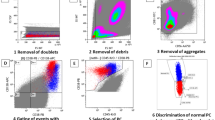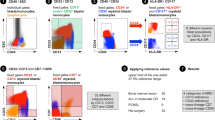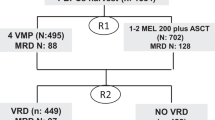Abstract
Minimal residual disease (MRD) cells are thought to be responsible for the persistence and relapse of acute myeloid leukemia (AML). Flow cytometric MRD detection by the establishment of a leukemia-associated phenotype (LAP) at diagnosis can be used in 80% of AML patients, allowing detection and functional characterization of MRD in follow-up bone marrow. One of the mechanisms contributing to inefficient chemotherapy is apoptosis resistance. Measuring apoptosis parameters in MRD cells will help to unravel the importance of apoptosis resistance in AML. We therefore developed a four-color flow cytometry method that enables establishment of apoptosis-related protein expression such as Bcl-2, Bcl-xL, Mcl-1 and Bax at diagnosis and in MRD. Firstly, validation of this assay using Western blot analysis in five leukemia cell lines showed a significant correlation (R=0.70: P<0.0001). Secondly, the influence of the permeabilization procedure on LAP expression was investigated in 38 AML samples at diagnosis and in 42 MRD samples. Quantification of the frequency of LAP+ cells with and without permeabilization showed no significant differences (diagnosis: P= 0.57, follow-up: P= 0.43). The flow cytometric protocol thus enables analysis of apoptosis-related proteins at different stages of the disease, which will lead to a better understanding of the role of apoptosis resistance in the emergence of MRD in AML.
This is a preview of subscription content, access via your institution
Access options
Subscribe to this journal
Receive 12 print issues and online access
$259.00 per year
only $21.58 per issue
Buy this article
- Purchase on Springer Link
- Instant access to full article PDF
Prices may be subject to local taxes which are calculated during checkout



Similar content being viewed by others
References
Lowenberg B, Downing JR, Burnett A . Acute myeloid leukemia. N Engl J Med 1999; 341: 1051–1062.
Burnett AK, Goldstone AH, Stevens RM, Hann IM, Rees JK, Gray RG et al. Randomised comparison of addition of autologous bone-marrow transplantation to intensive chemotherapy for acute myeloid leukemia in first remission: results of MRC AML 10 trial. UK Medical Research Council Adult and Children's Leukemia Working Parties. Lancet 1998; 351: 700–708.
Harousseau JL, Cahn JY, Pignon B, Witz F, Milpied N, Delain M et al. Comparison of autologous bone marrow transplantation and intensive chemotherapy as postremission therapy in adult acute myeloid leukemia. The Groupe Ouest Est Leucemies Aigues Myeloblastiques (GOELAM). Blood 1997; 90: 2978–2986.
Campana D, Pui CH . Detection of minimal residual disease in acute leukemia: methodologic advances and clinical significance. Blood 1995; 85: 1416–1434.
San Miguel JF, Martinez A, Macedo A, Vidriales MB, Lopez-Berges C, Gonzalez M et al. Immunophenotyping investigation of minimal residual disease is a useful approach for predicting relapse in acute myeloid leukemia patients. Blood 1997; 90: 2465–2470.
Terstappen LW, Safford M, Konemann S, Loken MR, Zurlutter K, Buchner T et al. Flow cytometric characterization of acute myeloid leukemia. Part II. Phenotypic heterogeneity at diagnosis. Leukemia 1992; 6: 70–80.
Venditti A, Buccisano F, Del Poeta G, Maurillo L, Tamburini A, Cox C et al. Level of minimal residual disease after consolidation therapy predicts outcome in acute myeloid leukemia. Blood 2000; 96: 3948–3952.
San Miguel JF, Vidriales MB, Lopez-Berges C, Diaz-Mediavilla J, Gutierrez N, Canizo C et al.. Early immunophenotypical evaluation of minimal residual disease in acute myeloid leukemia identifies different patient risk groups and may contribute to postinduction treatment stratification. Blood 2001; 98: 1746–1751.
San Miguel JF, Ciudad J, Vidriales MB, Orfao A, Lucio P, Porwit-MacDonald A et al. Immunophenotypical detection of minimal residual disease in acute leukemia. Crit Rev Oncol Hematol 1999; 32: 175–185.
Macedo A, Orfao A, Ciudad J, Gonzalez M, Vidriales B, Lopez-Berges MC et al. Phenotypic analysis of CD34 subpopulations in normal human bone marrow and its application for the detection of minimal residual disease. Leukemia 1995; 9: 1896–1901.
Yin JA, Tobal K . Detection of minimal residual disease in acute myeloid leukemia: methodologies, clinical and biological significance. Br J Haematol 1999; 106: 578–590.
Scolnik MP, Morilla R, de Bracco MM, Catovsky D, Matutes E . CD34 and CD117 are overexpressed in AML and may be valuable to detect minimal residual disease. Leukemia Res 2002; 26: 615–619.
Baer MR, Stewart CC, Dodge RK, Leget G, Sule N, Mrozek K et al. High frequency of immunophenotype changes in acute myeloid leukemia at relapse: implications for residual disease detection (Cancer and Leukemia Group B Study 8361). Blood 2001; 97: 3574–3580.
Macedo A, San Miguel JF, Vidriales MB, Lopez-Berges MC, Garcia-Marcos MA, Gonzalez M et al. Phenotypic changes in acute myeloid leukemia: implications in the detection of minimal residual disease. J Clin Pathol 1996; 49: 15–18.
Oelschlagel U, Nowak R, Mohr B, Thiede C, Ehninger G, Schaub A et al. Specificity of immunophenotyping in acute promyelocytic leukemia. Cytometry 2000; 42: 396–397.
Stoetzer OJ, Nussler V, Darsow M, Gullis E, Pelka-Fleischer R, Scheel U et al. Association of bcl-2, bax, bcl-xL and interleukin-1 beta-converting enzyme expression with initial response to chemotherapy in acute myeloid leukemia. Leukemia 1996; 10 (Suppl 3): S18–S22.
Campos L, Rouault JP, Sabido O, Oriol P, Roubi N, Vasselon C et al. High expression of bcl-2 protein in acute myeloid leukemia cells is associated with poor response to chemotherapy. Blood 1993; 81: 3091–3096.
Lauria F, Raspadori D, Rondelli D, Ventura MA, Fiacchini M, Visani G et al. High bcl-2 expression in acute myeloid leukemia cells correlates with CD34 positivity and complete remission rate. Leukemia 1997; 11: 2075–2078.
Maung ZT, MacLean FR, Reid MM, Pearson AD, Proctor SJ, Hamilton PJ et al. The relationship between bcl-2 expression and response to chemotherapy in acute leukemia. Br J Haematol 1994; 88: 105–109.
Karakas T, Maurer U, Weidmann E, Miething CC, Hoelzer D, Bergmann L . High expression of bcl-2 mRNA as a determinant of poor prognosis in acute myeloid leukemia. Ann Oncol 1998; 9: 159–165.
van der Pol MA, Pater JM, Feller N, Westra AH, van Stijn A, Ossenkoppele GJ et al. Functional characterization of minimal residual disease for P-glycoprotein and multidrug resistance protein activity in acute myeloid leukemia. Leukemia 2001; 15: 1554–1563.
Bradford MM . A rapid and sensitive method for the quantitation of microgram quantities of protein utilizing the principle of protein-dye binding. Anal Biochem 1976; 72: 248–254.
Laemmli UK . Cleavage of structural proteins during the assembly of the head of bacteriophage T4. Nature 1970; 227: 680–685.
Feller N, Schuurhuis GJ, van der Pol MA, Westra AH, Weijers GWD, van Stijn A et al. High percentage of CD34 positive cells in autologous AML peripheral blood stem cell products reflects inadequate in vivo purging and low chemotherapeutic toxicity in a subgroup of patients with poor clinical outcome. Leukemia 2003 17: 68–75.
Dragowska WH, Lopes de Menezes DE, Sartor J, Mayer LD . Quantitative fluorescence cytometric analysis of Bcl-2 levels in tumor cells exhibiting a wide range of inherent Bcl-2 protein expression: correlation with Western blot analysis. Cytometry 2000; 40: 346–352.
Lacombe F, Durrieu F, Briais A, Dumain P, Belloc F, Bascans E et al. Flow cytometry CD45 gating for immunophenotyping of acute myeloid leukemia. Leukemia 1997; 11: 1878–1886.
Andreeff M, Jiang S, Zhang X, Konopleva M, Estrov Z, Snell VE et al. Expression of Bcl-2-related genes in normal and AML progenitors: changes induced by chemotherapy and retinoic acid. Leukemia 1999; 13: 1881–1892.
Vaughan AT, Betti CJ, Villalobos MJ . Surviving apoptosis. Apoptosis 2002; 7: 173–177.
Milella M, Kornblau SM, Estrov Z, Carter BZ, Lapillonne H, Harris D et al. Therapeutic targeting of the MEK/MAPK signal transduction module in acute myeloid leukemia. J Clin Invest 2001; 108: 851–859.
Jia L, Srinivasula SM, Liu FT, Newland AC, Fernandes-Alnemri T, Alnemri ES et al. Apaf-1 protein deficiency confers resistance to cytochrome c-dependent apoptosis in human leukemic cells. Blood 2001; 98: 414–421.
Shinozawa I, Inokuchi K, Wakabayashi I, Dan K . Disturbed expression of the anti-apoptosis gene, survivin, and EPR-1 in hematological malignancies. Leukemia Res 2000; 24: 965–970.
Tamm I, Kornblau SM, Segall H, Krajewski S, Welsh K, Kitada S et al. Expression and prognostic significance of IAP-family genes in human cancers and myeloid leukemias. Clin Cancer Res 2000; 6: 1796–1803.
Author information
Authors and Affiliations
Additional information
The Dutch Cancer Foundation financially supported this work.
Rights and permissions
About this article
Cite this article
van Stijn, A., Kok, A., van der Pol, M. et al. A flow cytometric method to detect apoptosis-related protein expression in minimal residual disease in acute myeloid leukemia. Leukemia 17, 780–786 (2003). https://doi.org/10.1038/sj.leu.2402885
Received:
Accepted:
Published:
Issue Date:
DOI: https://doi.org/10.1038/sj.leu.2402885
Keywords
This article is cited by
-
Enhancement in alpha-tocopherol succinate-induced apoptosis by all-trans-retinoic acid in primary leukemic cells: role of antioxidant defense, Bax and c-myc
Molecular and Cellular Biochemistry (2008)
-
Phosphoinositide 3-kinase/Akt signaling pathway and its therapeutical implications for human acute myeloid leukemia
Leukemia (2006)
-
Gene expression profiling of minimal residual disease in acute myeloid leukaemia by novel multiplex-PCR-based method
Leukemia (2004)
-
Minimal residual disease cells in AML patients have an apoptosis-sensitive protein profile
Leukemia (2004)



